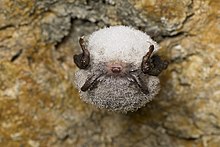| Daubenton's bat | |
|---|---|

| |
| Conservation status | |
 Least Concern (IUCN 3.1) | |
| Scientific classification | |
| Domain: | Eukaryota |
| Kingdom: | Animalia |
| Phylum: | Chordata |
| Class: | Mammalia |
| Order: | Chiroptera |
| Family: | Vespertilionidae |
| Genus: | Myotis |
| Species: | M. daubentonii |
| Binomial name | |
| Myotis daubentonii (Kuhl, 1817) | |

| |
Daubenton's bat or Daubenton's myotis (Myotis daubentonii) is a Eurasian bat with rather short ears. It ranges from Ireland to Japan (Hokkaido) and is considered to be increasing its numbers in many areas.
This bat was first described in 1817 by Heinrich Kuhl, who named it in honour of French naturalist Louis-Jean-Marie Daubenton.
Description
Daubenton's bat is a medium-sized to small species. The bat's fluffy fur is brownish-grey on the back and silvery-grey on the underside. Juveniles have darker fur than adults. The bats have reddish-pink faces and noses, but the area around the eyes is bare. When the bat is agitated, the ears are held at right angles. The wings and tail membrane are dark brown.
Daubenton's bat is typically 45 to 55 mm long, with an average wingspan of 240 to 275 mm, and weighs between 7 and 15 g.
Lifespan
Daubenton's bats can live for up to 22 years. In Lieto, Finland a male called Nestori that lives in an old water mill has been tracked since 2008 and was approximately 21 years old in 2024.
Habitat

Daubenton's bat is found throughout Ireland and Europe, and as far as Japan and Korea. The bat is mostly found in woodlands and often chooses roosts close to water sources such as rivers or canals.
Summer colonies are formed in caves, tunnels, cellars, mines, and underneath bridges. These colonies are also always near water. Daubenton's bat hibernates in the same type of locations from September to late March or April.
Hunting and diet
Daubenton's bat is insectivorous and uses echolocation to find prey and orient itself at night. Bats emit sounds too high in frequency for humans to detect, and interpret the echoes created to build a "sound picture" of their surroundings. Daubenton's bat emits echolocation calls at frequencies between 32 and 85 kHz, though typical calls peak at 45 to 50 kHz; the calls have a duration of 3.3 ms.
The bats emerge at twilight to hunt for insects over the water. Their main diets consist mainly of non-biting midges and other midges, small flies, mayflies, and moths are regularly found in their diet. Daubenton's bat often eats its prey while still in flight. A seven-gram Daubenton's bat often returns weighing 11 grams after a one-hour feeding, increasing its body weight by 57%.
Breeding
Mating occurs in autumn and fertilisation takes place the following spring. Females gather in maternity colonies of 40 to 80 bats during June and July. Daubenton's bat is able to fly three weeks after birth and reaches independence at 6 to 8 weeks of age.
Conservation
All bats in Britain are protected under Schedule 5 of the Wildlife and Countryside Act of 1981. The bats are also protected by the Conservation Regulations of 1994.
See also
- Sakhalin myotis (M. abei)
References
| This article needs additional citations for verification. Please help improve this article by adding citations to reliable sources. Unsourced material may be challenged and removed. Find sources: "Daubenton's bat" – news · newspapers · books · scholar · JSTOR (November 2012) (Learn how and when to remove this message) |
- Kruskop, S.V.; Godlevska, L.; Bücs, S.; Çoraman, E.; Gazaryan, S. (2021) . "Myotis daubentonii". IUCN Red List of Threatened Species. 2020: e.T85342710A195858793. doi:10.2305/IUCN.UK.2020-2.RLTS.T85342710A195858793.en. Retrieved 18 April 2021.
- Myotis daubentonii - Science for Nature Foundation
- Palokallio, Netta (12 July 2024). "Myllystä löytyi vanhan miehen näköinen lepakkovanhus". Helsingin Sanomat. Retrieved 28 October 2024.
- Parsons, S. & Jones, G. (2000). "Acoustic identification of twelve species of echolocating bat by discriminant function analysis and artificial neural networks" (PDF). Journal of Experimental Biology. 203 (17): 2641–2656. doi:10.1242/jeb.203.17.2641. PMID 10934005.
- Obrist, Martin K.; Boesch, Ruedi & Flückiger, Peter F. (2004). "Variability in echolocation call design of 26 Swiss bat species: consequences, limits and options for automated field identification with a synergetic pattern recognition approach" (PDF). Mammalia. 68 (4): 307–322. doi:10.1515/mamm.2004.030. S2CID 86180828.
- Vesterinen, Eero J.; Ruokolainen, Lasse; Wahlberg, Niklas; Peña, Carlos; Roslin, Tomas; Laine, Veronika N.; Vasko, Ville; Sääksjärvi, Ilari E.; Norrdahl, Kai (2016-04-01). "What you need is what you eat? Prey selection by the bat Myotis daubentonii". Molecular Ecology. 25 (7): 1581–1594. Bibcode:2016MolEc..25.1581V. doi:10.1111/mec.13564. ISSN 1365-294X. PMID 26841188. S2CID 206183142.
- Vesterinen, Eero J.; Lilley, Thomas; Laine, Veronika N.; Wahlberg, Niklas (2013). "Next Generation Sequencing of fecal DNA reveals the dietary diversity of the widespread insectivorous predator Daubenton's bat (Myotis daubentonii) in southwestern Finland". PLOS ONE. 8 (11): e82168. Bibcode:2013PLoSO...882168V. doi:10.1371/journal.pone.0082168. PMC 3842304. PMID 24312405.
External links
| Taxon identifiers | |
|---|---|
| Myotis daubentonii |
|
| Vespertilio daubentonii | |